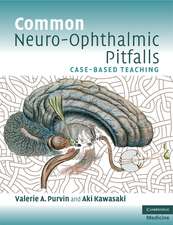Genetics and the Electroencephalogram
Autor Friedrich Vogelen Limba Engleză Paperback – 18 aug 1999
Preț: 713.70 lei
Preț vechi: 751.25 lei
-5% Nou
Puncte Express: 1071
Preț estimativ în valută:
136.56€ • 143.35$ • 113.35£
136.56€ • 143.35$ • 113.35£
Carte tipărită la comandă
Livrare economică 11-25 aprilie
Preluare comenzi: 021 569.72.76
Specificații
ISBN-13: 9783540655732
ISBN-10: 3540655735
Pagini: 256
Ilustrații: XII, 244 p. 112 illus.
Dimensiuni: 155 x 235 x 13 mm
Greutate: 0.37 kg
Ediția:Softcover reprint of the original 1st ed. 2000
Editura: Springer Berlin, Heidelberg
Colecția Springer
Locul publicării:Berlin, Heidelberg, Germany
ISBN-10: 3540655735
Pagini: 256
Ilustrații: XII, 244 p. 112 illus.
Dimensiuni: 155 x 235 x 13 mm
Greutate: 0.37 kg
Ediția:Softcover reprint of the original 1st ed. 2000
Editura: Springer Berlin, Heidelberg
Colecția Springer
Locul publicării:Berlin, Heidelberg, Germany
Public țintă
ResearchCuprins
1 The Problem.- 1.1 The Purpose of This Book.- 1.2 Disturbances Leading to Disease.- 1.3 Molecular Mechanisms of Some Hereditary Types of Epilepsy.- 1.4 Possible Significance of These Studies for Genetic Analysis of the Human EEG.- 2 The Human EEG: General Aspects.- 2.1 History.- 2.2 EEG Recording.- 2.3 EEG Evaluation.- 2.4 The “Normal” Human EEG.- 2.5 The EEG in Childhood and Youth.- 2.6 EEG Changes with Advancing Age, I.- 2.7 EEG Differences Between Men and Women.- 2.8 Changes in the EEG with Advancing Age, II.- 2.9 Effects of Drugs on the EEG.- 2.10 The EEG and Somatic Diseases.- 3 Genetic Studies: Twin Studies.- 3.1 General Remarks on the Twin Method.- 3.2 The First EEG Twin Studies.- 3.3 Our Own EEG Twin Studies.- 3.4 The EEG in Aging Twins.- 3.5 Studies on Twins Reared Apart.- 3.6 Alpha Attenuation Response.- 3.7 More Recent Twin Studies in Which Methods of Computerized EEG Analysis Are Used.- 3.8 Specific Problems to Be Studied by Comparison of Twins.- 3.9 Conclusions from EEG Twin Studies.- 4 Family Studies on the Normal EEG.- 4.1 Family Studies of the Normal EEG: First Attempts and Various Approaches.- 4.2 EEG Variants and Their Genetic Analysis.- 4.3 The “Low-Voltage EEG” and Its Borderline Cases.- 4.4 Linkage Study.- 4.5 Fast (16-19 c/s) Alpha Variants.- 4.6 The 4-5 c/s Rhythm.- 4.7 Monomorphic Alpha Waves.- 4.8 The EEG with Prominent Beta Waves.- 4.9 EEG Variants with Groups of Beta Waves with a Maximum in Frontoprecentral Leads.- 4.10 The EEG with Diffuse Beta Waves.- 4.11 Other Family Studies Using Methods of Quantitative, Biometrical Methods.- 4.12 EEG Variants and Dopamine ?-Hydroxylase Values in the Blood.- 5 Event-Related (Evoked) EEG Potentials.- 5.1 Principle and Methods.- 5.2 Twin and Family Studies.- 5.3 The Effect of the Resting EEG,Especially Hereditary EEG Variants, on Parameters of Evoked Potentials.- 6 The Normal Human EEG as a Research Tool in Human Behavior Genetics.- 6.1 General Introduction to the Problem.- 6.2 The EEG and Normal Psychology: General Considersations.- 6.3 EEG Alpha Activity and Intelligence.- 6.4 Variants of the Normal EEG and Personality: Concepts and Data.- 6.5 Variation in the Normal EEG: Performance and Personality: Results.- 6.6 An Attempt at Characterization of EEG Variants Based on Test Results.- 6.7 “Cognitive Styles” and EEG Variants.- 6.8 Possible Neurophysiological Mechanisms.- 6.9 A Possible Function of EEG Waves, Especially Alpha Waves.- 6.10 Earlier Attempts at Connecting Neurophysiological Mechanisms with Aspects of Personality.- 6.11 Results of Our Psychological Studies in the Light of Neurophysiological Evidence.- 6.12 Critical Evaluation on the Results About EEG Characteristics and Normal Psychology: What Can Be Regarded as Confirmed, What Is Likely, and What Is Hypothetical and Could Be Clarified by Further Research?.- 6.13 Psychological Observations on Carriers of the 4-5 c/s Rhythm.- 6.14 EEG and Normal Psychological Development in Childhood.- 6.15 Visual and Auditory Evoked EEG Potentials and Mental Performance.- 7 EEG Variation in Psychologically Borderline Conditions such as Alcoholism, Anxiety Disorders, and Certain Neurotic States, Psychiatric Disorders.- 7.1 Alcoholism and the Resting EEG.- 7.2 Alcoholism and Evoked EEG potentials.- 7.3 The Low-Voltage EEG in Relation to Anxiety Disorders.- 7.4 Psychopathy and Delinquiency.- 7.5 Other Types of “Abnormal” and “Neurotic” Behavior: Psychosomatic Complaints.- 7.6 The EEG in Behavioral Anomalies of Children and Youth.- 7.7 Affective Disorders.- 7.8 Schizophrenia.- 8 The EEG in HereditaryAnomalies and Diseases.- 8.1 Syndromes Caused by Chromosomal Aberrations.- 8.2 Hereditary Diseases Caused by Gene Mutations.- 8.3 Hereditary EEG Variants Suggesting a Higher Suceptibility for Epilepsy.
Textul de pe ultima copertă
This book describes genetic studies of normal EEG findings, mainly twin studies and family studies. Among the family studies, EEG variants having a single mendelian mode of inheritance are emphasized, the available data are described critically and in detail. Morevover, psychological studies on carriers of these EEG variants are described and discussed critically. The significance of an EEG for psychological anomalies such as psychoses, psycho- and sociopathies, and alcohol addiction is considered. Features of a "normal" EEG that point to a higher susceptibility for epilepsy are mentioned. Genetic aspects of event-related (evoked) potentials are also described. There are many EEG curves as well as other graphics. This is the first monograph on this topic, and combines two fields of expertise - human genetics and clinical neurophysiology - that are normally strictly separated.


















